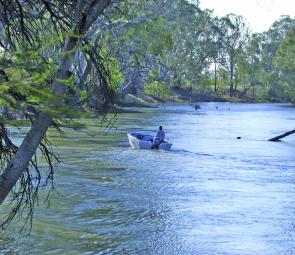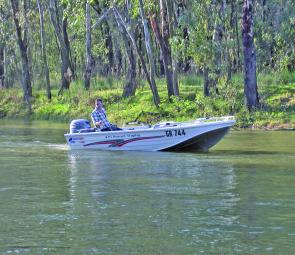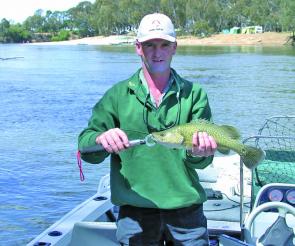The Murray River is the obvious destination to open your Murray cod season. The river has excellent bush camping reserves along its length, adding to the experience.
Every major town along the Murray is close to a cod hot spot. Despite an overall reduction in cod numbers, they’re still quite widespread so they’re worth pursuing.
Downstream of Lake Hume and Albury Wodonga yields some great fishing, although faster water in some of these areas may mean you have to adapt to the flow.
The areas around the Corowa are similarly good, offering productive stretches of water, all the way down to the weir-influenced water at Lake Mulwala.
Immediately below Lake Mulwala, the seasonal closed area of the river reopens at the same time as Murray cod open season and this, too, is a sensational piece of river.
A few years back I spent a bit of time fishing around Cobram with guide and writer Roger Miles. The locals love Cobram and with good reason, it’s a Murray cod Mecca.
Around Echuca, The Narrows and Barmah are great areas, right through to above and below Torrumbarry Weir. Barham/Koondrook through to Swan Hill has some great water, as do the areas further downstream with Tooleybuc, Wood Wood and Boundary Bend popular and fruitful.
The river around Robinvale just continues to produce fish for lure casters, trollers and bait anglers.
The areas both above and below Mildura are fantastic, offering much variety. Above Mildura, expect shallower water fantastic for casting while below Mildura the water deepens substantially.
Areas around and beyond Wentworth, like Fort Courage, have those incredible, deep troll runs with water down to 12m or 40 old-fashioned feet.
The Edwards River around Deniliquin and the Darling north of Wentworth also offer excellent cod fishing with easy access.
Every feature mentioning Murray cod lakes should lead with the premier cod fishery, Lake Mulwala at Yarrawonga. Combine the country’s best cod fishery with the largest and best-run open fishing competition in the land, the Cod Classic, and you have a recipe for a cod opening weekend to remember!
Yarrawonga/Mulwala really is a holiday wonderland and a great place for the entire family to visit.
Most importantly, the cod are abundant. The lake is often criticised for having a large proportion of undersized fish (legal is 60cm) and this may well be the case; there are a lot of undersized fish caught.
There are also plenty of good-sized fish taken, with the occasional behemoth as well.
Anglers are often spoilt with numbers of fish in this lake. I have taken 18 cod in a morning casting session with a mate and that clouds the perception just a little. It’s a top spot; if you haven’t been there, go!
Hume Weir, at Albury-Wodonga, is an excellent mixed fishery with Murray cod and golden perch living (relatively) harmoniously with trout.
For the grass-roots anglers – and there are still plenty out there – there’s nothing better than selecting a likely-looking spot, drifting down a favoured bait on a needle-sharp hook and waiting for a cod.
At the top of the bait tree is the bardi grub; Murray cod simply can’t go past them. They are difficult to source and expensive to purchase.
There is a viable alternative out there nowadays, the cheese bardi mould. These moulds turn out perfect mozzarella bardies which gain results just as good as the real thing.
Don’t let the lack of a mould put you off trying cheese for bait, the cod love a cubed portion as well.
The old favourites still work well so don’t be scared to pop on a good-sized yabby or a nice succulent scrub worm.
Smaller worms and river shrimp work well but you’ll be attracting the smaller species in the river as well, like golden and silver perch, redfin and European carp.
If you have Murray cod in your sights, try to stick to the larger baits.
Hook size is largely dependent on the bait being presented, with 4/0 to 7/0 usually sufficient. Buy the best hooks you can afford; the chemically sharpened ones are the optimum choice.
As with all bait fishing, use only enough lead to anchor your bait on the bottom, keeping in mind any flow in the river or the activity of your bait, especially yabbies.
In and around the snags is a great place to start bait fishing, but slightly upstream of a nice snag pile will also have a cod with a keen nose sniffing up the minute berley trail that forms from the bait.
For the more adventurous anglers, give your bait a thorough hosing down with CRC before sending them down! I know it flies in the face of all we’re taught as budding anglers to keep our hands free of petrol and sunscreen when fishing, but trust me – it works.
Being a rust preventer, CRC apparently has a large fish oil base, so it’s little wonder it turns on the cod. All I can say is give it a go. You might get a big surprise!
Trolling lures is a favourite and incredibly effective way of turning up some nice fish. It’s often the only way to present a lure to a fish holding in some of the deeper areas of our rivers and lakes.
Trolling is also accessible to anyone with a basic tinny; the mega-boats with high-tech, bow-mounted electrics are not necessary to troll lures. As long as you have an outboard capable of idling down nice and slowly, you’re in with a show trolling a big, slow-wobbling cod lure.
Another advantage is the sheer amount of water you can cover searching out your fish. If one area is shut down, you’ll soon be in another, knocking at another fish’s snag.
But there’s a lot to be said for picking a short troll run of a couple of hundred metres and methodically working it over, exhausting every possibility of goading that angry cod into swiping at your lure.
There are a couple of disadvantages to trolling.
The lures often won’t get near a fish holding deep within cover, it simply won’t see the lure or will be too lazy to rush out the extra few metres to swipe at it.
Then there is the number of times a fish sees a trolled lure. Some fish need multiple views of a lure to strike and even then it can take a change of lure or colour to get a hit. Trolled lures simply don’t allow that bang, bang, bang, ‘in their face’ presentation that casting achieves.
Anglers applying a little science to their trolling will gain far better results than those who don’t.
Using your sounder, aim to keep your lures within 1m of the bottom structure, that’s where the cod will be. You need to have an intimate knowledge of the swimming depths of your favourite cod lures.
If your lure is occasionally nudging the structure, that’s perfect. If you happen across a run that looks particularly promising, either with structure or arches on your sounder, work it over from all different angles before moving on.
This way any resident fish will get a second or third look at your lure, enticing a strike.
Trolling speed is variable, but let your rod tip be your guide. If your lure is transferring that rhythmic action to the rod tip and you feel it’s also reaching its optimum depth, that’s good.
There used to be a school of thought for ultra-slow troll speeds but some lures won’t work properly or achieve depth unless there’s a little more speed involved. A lure trolled downstream in some sections of the river will not have a hope of reaching depth without a little speed.
There are a lot of trolling lures out there. Some of my favourites include the Goulburn Lures Old Codger, Custom Crafted Lures, Legend Lures and the ever-popular OarGee range, which now has an ultra-deep diver in the stable.
There are a lot of excellent Australian-made brands and all work well.
The only bad lures I’ve seen are the cheap, nasty rip-offs of some of our more successful styles.
Anglers should bypass these in the tackle shops and spend a little extra on the real thing. There’s no comparison.
Casting and retrieving is popular because of the ability to get a lure right in among the snags where a fish may be holding, as often as is required to gain a strike.
Spinnerbaits and their variants need to sink to depth before the angler starts the retrieve, as will the lipless rattling lures.
Diving hard-bodied lures need to be ‘dug in’ during the first stage of the retrieve to achieve the correct depth.
On that note, don’t be scared to change styles if a strike is felt which in resulting casts doesn’t produce the fish. Often a complete change of lure style is enough to turn a looker into a striker.
Casting lures used to be limited to spinnerbaits and bibbed trolling-style lures but things have changed.
Mumblers and Chatterbaits are spinnerbait variants and lipless rattling crankbaits have taking the freshwater angling world by storm in recent years.
Soft plastics simply haven’t caught on for Murray cod to date. On the smaller species, the new big thing are the vibrating blades but it remains to be seen whether they take off for cod.
Popular spinnerbaits are the Bassman and Outlaw ranges, amongst others. These two brands particularly have upgraded hardware to cope with the strength of fish up to 50kg and beyond.
The best Murray cod spinnerbaits also carry a soft plastic trailer and a stinger hook.
The Mumbler variants carry a flat front blade, a large soft plastic minnow and often a spinnerbait skirt as well, and offer a vast difference to the traditional spinnerbait.
The best lipless rattlers by far are the Jackall range, but they aren’t cheap. There are cheaper brands available for those with shallower pockets and all are capable of catching fish in the right place at the right time.
Your retrieve speed will be determined by the style of lure.
Spinnerbaits are very sensitive to speed. Those with Colorado blades require far less speed to work properly than those with willow blades.
The speed of Mumblers and their variants will be determined by the rod tip action. Lipless minnows can be gently retrieved, lifted and dropped or any manner of styles in between. Mix it up for best results.
Now it’s up to you to get out amongst them. But be aware that chasing these big green fish is incredibly addictive. Lifetime addictions resulting in sheds full of rods, reels and lures are the frequent consequence, one I’m willing to wear.
Facts
LICENSING
The Murray River is NSW waters so a NSW licence is required to fish there regardless of where you’re from. Lake Hume is designated Victorian water for licensing purposes and Lake Mulwala is designated NSW water.
In Victoria Murray cod now effectively have a size slot limit between 60cm and 100cm with a possession limit of two fish. The NSW minimum size is 60cm with a bag limit of two, with only one fish 100cm.
Facts
CATCH AND RELEASE
Murray cod are not prolific. Past fishing practices, water mismanagement and feral competitor species brought a decline in populations. Recent anecdotal evidence suggests European carp are far less prolific than 30 years ago and some of this can be attributed to evolving angling practices which entail releasing larger cod that predate on carp.
Without a doubt, catch-and-release is catching on. There is simply no need to kill large fish for bragging rights these days, digital cameras have relegated this practice to the dark ages. Large fish are the breeders of the system and are essential for the survival of the species.

Not long ago, trolling was the only way to approach fast, deep Murray cod water like this but ‘new’ lure designs have allowed casters to get in on the act.

Spinnerbaits are relatively snag-resistant and once you start cranking at the right speed the cod love them.

Trolling is also accessible to anyone with a basic tinny.

Not every cod is going to be more than a metre long or over 50kg – far from it – but it’s good to be prepared.




